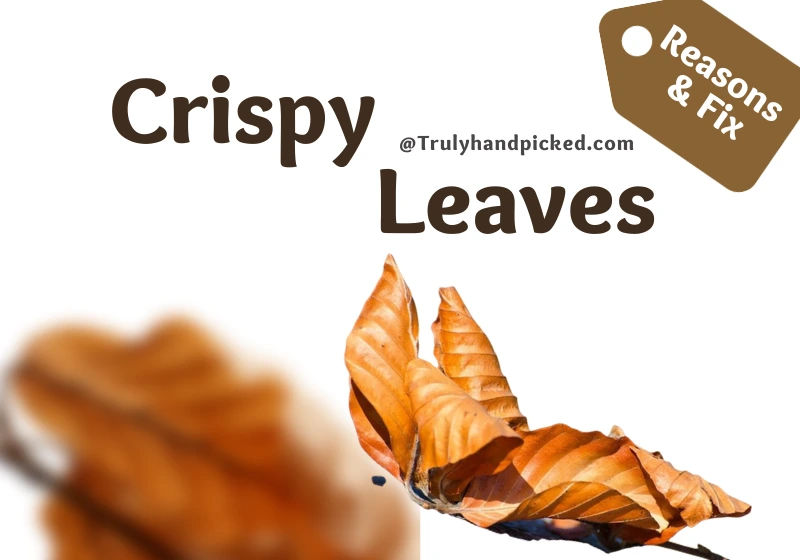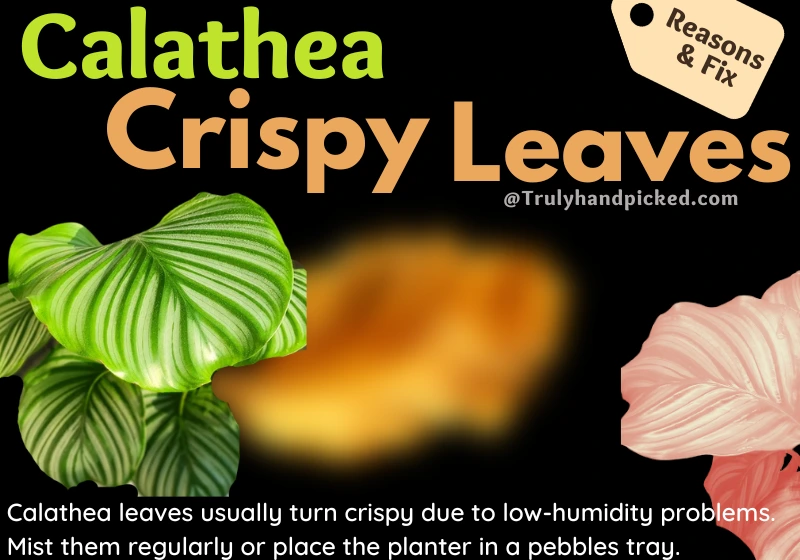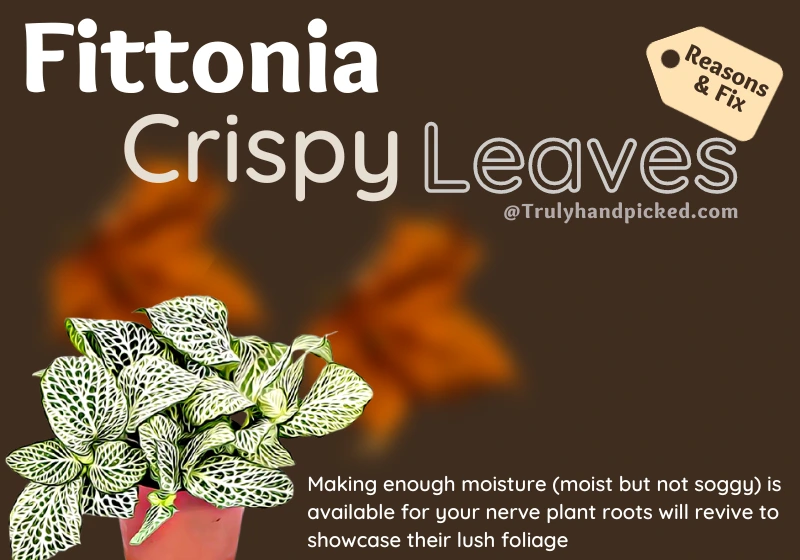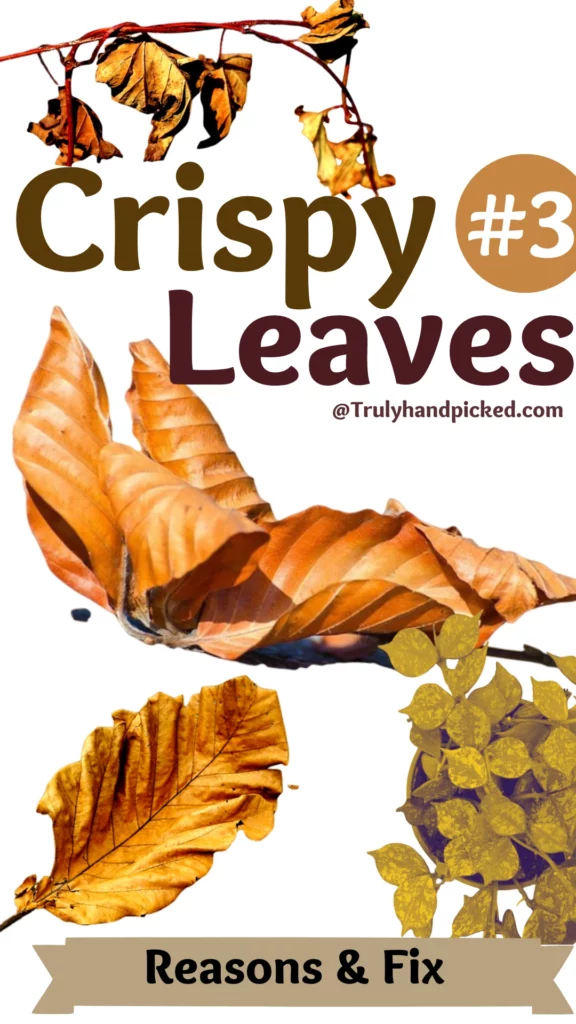Crispy edges or totally crispy leaves are a common problem of several indoor plants with a lack of care. Indoor plants may look easy to care but they are intricate to keep alive healthily all the time.
Simple misconduct in their routine can invite serious consequences to your growing plant. Crispy leaves issue is just one of them.
In short: The majority of plants with crispy and dry brown leaves are because of underwatering, overwatering, and sunburn.
You can trim off the leave if it’s more than half brown and check the lighting issue, look for a proper drainage system, and do install an automatic watering system if you are going to be away from your plant for a long.
Look for life signs of your crispy plant, if it’s still alive you can try reporting it to an optimum pot (succulent or moisture-loving plants) with a nourishing potting mix.
After repotting water and place it in partial shade to prevent shock and get it back to normal in a few days.
Hopefully, you can save your plant leaves from this condition and revive the foliage capably. You only need to do some basic deviations in their regular caring regimen.
Here we emerge with some top ideas on how to be certain about the exact cause of crispy leaves on your plant and how to revive them either. Let’s check them out and say goodbye to those brittle leaves forever from your plants-

Reasons for Crispy Leaves on Your Plant:
These crunchy or peppery leaves can appear every time on your plant due to some common causes. They are like-
Underwatering:
This problem occurs for these reasons-
- When you keep the soil of your plant bone dry
- If you don’t water your plant at least twice a month
- When you put your plant under direct sunlight for long without watering
Overwatering:
This issue appears-
- When you don’t water your growing plant according to its water needs
- If you don’t let the soil a bit dry between watering
- When you keep the plant in a soggy or water-logged situation for long
Fungal Diseases:
The fungal disease may appear on your plant due to-
- When you use low-quality water to hydrate your plant
- If you keep the root in the water-logged situation for long
- When you bring an already infected plant from the nursery to your house
Overfertilization:
It can happen-
- When you feed your plant more than its actual needs
- If there is a salt buildup in your plant due to consistent overfertilization
- When you apply raw fertilizer unnecessarily to your plant without diluting it
Root Issues:
This may happen because of-
- Using a pot or potting mix with poor-draining quality
- Growing your plant in a too small or too big planter
- Not repotting your plant for a long while
Low Humidity:
It may happen-
- When you don’t check and look for the required humidity level of your plant
- If you keep your plant under a full shade area for long
- Of when you place your plant under the full sun exposure for long without maintaining proper humidity

How to Fix Crispy Leaves
If you don’t want to hand over your plant with crispy leaves and want to give your gardening skills one more chance, simply try these hacks assiduously-
Balance The Light Exposure:
Sometimes, balancing the light and providing the exact amount of sunlight to your plant can save your plant leaves from the crispy condition. You should remember that your growing indoor plants neither need too much sun exposure nor lack of light either. To balance the exact light amount for your plant, follow these tips-
- Know the true light requirement of your plant
- Place the plant at a spot exactly depending on that requirement
- Move and rotate your plant infrequently to give each corner of your plant the same amount of light
Trim The Overcrowded Plant:
If the new foliage doesn’t get enough space to thrive, they soon will suffer from lack of light, lack of nutrients, or lack of moisture too. These moments will drag your plant towards the stage of crispy leaves shortly. Roots of plants with a long unpruned session also can’t provide proper support to a large quantity of foliage. so, you can try these hacks here-
- Find out the old and discolored parts from your plant
- Shed them quickly with a disinfected pruner
- Don’t leave any leggy or teeming stems on your plant either to complete the process well
Repot Your Plant:
Repotting is one of the most crucial solutions you can take to reverse the crispy leaves of your plant successfully. Normal plant leaves sometimes may turn dry and crispy when they don’t have enough space for their spreading roots. Keeping the roots of a plant in the same old potting soil can also initiate the issue of crispy foliage in a plant. You can try these tips in this regard-
- Pick a planter that is wider than the previous one
- Bring a fresh set of potting soil
- Add water-storing crystals to the planter to keep your plant safe from dehydration shortly
Water Properly:
Maintaining a proper watering schedule is the key to keeping the possibilities of crispy leaves of your plant at bay. It has been observed that if the watering schedule of a plant is perfect, the chances of dry leaves on that plant decrease naturally. Different plants have different types of water needs. Try to follow the regimen according to that needs. Here are some useful tips in this regard-
- Check the water need of your plant first, usually, once a week watering is good for most of the plants
- Make the watering schedule and consistency depending on that need
- Never let the soil of your plant dry for too long
Feed Adequately:
Like proper watering, exact fertilization is also crucial to keep a plant healthy with tender leaves. If your plant is well-nutrified, it can fight most of the fatal issues expertly including the crispy-leaves problem. However, you need to be attentive about not overdoing it in the way of proper feeding. So, here are some convenient tips in this attempt-
- Provide a proper nutrient boost to your plant every few months
- Fertilize your plant with the appropriate fertilization dose
- Water your plant thoroughly once you feel you overfertilize it
Keep Your Plant Disease or Insects Free:
Keeping your plant free from the grasp of any kind of disease or pests or bugs is another good way to keep the possibilities of crisp leaves fewer. Common pests and bugs of plants usually suck the essential nutrients from your plant through the sap. On the other hand, fungal or bacterial diseases don’t let the roots provide vital nutrients to the plant. In both cases, your plant can suffer from nutrient deficiency and then crisp leaves soon. So, you have to take initiatives to keep your plant free of some such nuisance, and here are some useful tips for this-
- Keep your plant in good condition or under a good climate
- Wipe your plant with damp cloths once a month
- Spray your plant with a good pesticide as well as fungicide solutions once a while
Try to find the actual cause of crispy leaves on your plant and apply the solution accordingly to get a speedy recovery from this condition.
FAQ: My Plant Leaves are Turning Crispy

Calathea Leaves Crispy:
Calathea leaves usually turn crispy due to low-humidity problems. Mist them regularly or place the planter in a pebbles tray to get rid of this issue permanently. You can trim the leaves if its more than half brown and crispy, less the leaf still serve a purpose for the plant.
Fittonia Leaves Crispy:

The most common cause of crispy in a Fittonia plant is lack of moisture or underwatering. Attempt to set the watering schedule of your Fittonia plants according to the water needs of your selected species. Making enough moisture (moist but not soggy) is available for your nerve plant roots will revive to showcase their lush foliage.
Begonia Leaves Crispy:
Begonia leaves can turn crispy and dry for the same underwatering reason. It can hit both old and new foliage similarly if you don’t manage a perfect watering schedule soon. Also trim off brown, black spots, and infected and old dry leaves from your begonia plants, so that it can focus its energy on growth instead of fighting back on these dying leaves.
Can You Revive a Plant With Crispy Leaves?
If your plant is not bony and at least half of the leaves are greenish or in their true color, then you can save your plant with crispy leaves and revive it to its previous form successfully with above mentioned effective solutions. Finding and applying them at an early stage will make the possibility of recovery higher.
